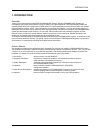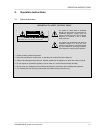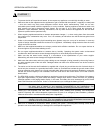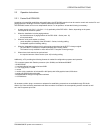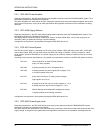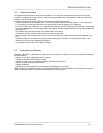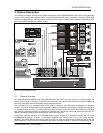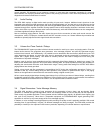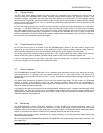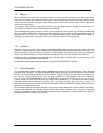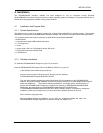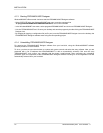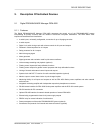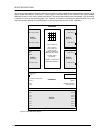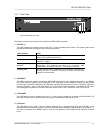
SYSTEM DESCRIPTION
3-2 PROANNOUNCE System User Handbook 1.1
normal operation, PC-interaction is not necessary. Anyway, in most cases the permanent connection of a computer
bears benefits, like displaying detailed status reports or the printing of protocols. It also offers the possibility for remote
diagnosis and remote maintenance via modem.
3.2 Audio Routing
The DPM 4000 employs a digital audio matrix providing 4 inputs and 4 outputs. Additional matrix junctions for the
integrated gong and alarm signal generators, the vocal recording/playback unit, and the lock-on of the pilot tone and its
evaluation are incorporated. All input signals and internally generated signals can be freely mixed inside the matrix and
outputted through the 4 amplifier channels. Routing speaker lines to these amplifier channels is achieved via the relay-
matrix, which offers up to four separate audio buses simultaneously, while the DPM 4000 takes over the management
of all these signals according to their priority.
Next to connecting paging stations, the audio inputs also serve for the connection of other audio sound sources, like
microphones, mixers, CD-players, cassette decks and DAT-recorders, tuners, etc. Several different input modules are
available to optimally adjust and match signal levels and connections.
3.3 Volume And Tone Controls / Delays
The PROANNOUNCE system provides individual volume controls for each input, output, and paging station. Even the
internal audio sources, like gong/alarm tone generators, voice message playback, and pilot tone generator employ
individual level controls, each. Additionally, it is possible to set an attenuation that unanimously affects the inputs. This
value determines the degree, by which the input signal is attenuated during the reproduction of messages or other
signals with a higher priority setting. This allows to smoothly fade-out and fade-in background music during the
transmission of important messages.
Besides, each of the four inputs embodies three fully parametric digital filters allowing for optimal tone control. The
filters provide different filter types like Hi-/Lo pass filters, shelving filters, and peak-dip-filters providing the possibility for
adjusting the sound within the entire audio transmission range. Factory-preset filter settings for the DPC 4000 Series
paging stations are already provided.
Setting volume levels and filter parameters is accomplished via PC during the configuration procedure. Further, it is
possible to alter any volume setting during the later operation of the system via special-function keys on the paging
stations or through external controls that are connected to analog or digital control inputs.
All four outputs employ digital delays allowing signal delays of up to 330 ms per channel. Natural delays, resulting from
loudspeaker positioning which causes time differences in the traveling of sonic events or environmental circumstances
related to architectural characteristics of the location, can be equalized without additional effort.
3.4 Signal Generators / Voice Message Memory
The DPM 4000 provides a variety of tone generators for the generation of gong, alarm, and text signals. Signal
generation is realized through DSP-algorithms, which are extremely flexible in use, so that they can be adjusted to
match nearly any possible application. Factory presets include 6 different gong signals, 18 different alarm signals, plus
sine cycle at any frequency. Other than in comparable equipment, the PROANNOUNCE signal generating DSP-
algorithms do not take up any extra storage of the voice message memory.
In addition, a voice message recording/playback module providing CD-quality sound is optionally available. With a total
recording time of approximately 6 minutes, 25 different messages are being managed. The DPM 4000 provides the
possibility to install up to four optional FLASH-memory modules, depending on individual desires or requirements.




